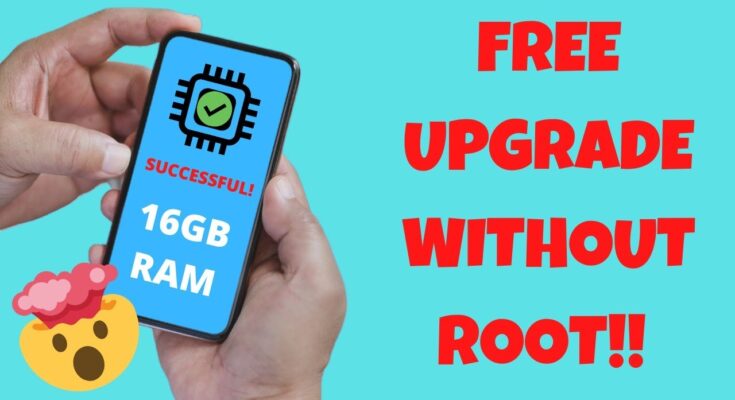Introduction
Is your Android device running slow? Are you struggling with low RAM and constant lag while multitasking? Many users face performance issues, especially on low-end devices. Fortunately, there’s a solution: SWAP – No ROOT. This method allows you to create a SWAP file on your device, enhancing performance without requiring root access. In this guide, we’ll explain what SWAP is, how it works, and how you can use it to boost your device’s speed effortlessly.
What is SWAP?
SWAP is a virtual memory technique that extends your device’s RAM by using a portion of your storage as additional memory. Normally, Android uses physical RAM to run applications, but when RAM is full, your device slows down or even crashes. With SWAP, your phone can allocate extra memory from storage, reducing lag and improving multitasking.
Benefits of Using SWAP – No ROOT
Many users hesitate to modify their devices due to root access requirements. However, with SWAP – No ROOT, you can enjoy several advantages without the need to root your phone:
- Improved Multitasking – Run multiple apps smoothly without crashes.
- Better Gaming Performance – Reduce lag and enhance FPS in heavy games.
- Extended Device Life – Minimize wear on RAM by offloading memory tasks.
- No Risk of Rooting – Keep your warranty and security intact.
How to Create a SWAP File Without Root
Creating a SWAP file without root is simple and requires only an app. Follow these steps:
Step 1: Download a SWAP File App
There are several apps available on the Play Store for creating a SWAP file. Some popular choices include:
- SWAP – No ROOT
- RAM Expander
- Virtual RAM Swap
Step 2: Allocate Storage for SWAP
Once you install a SWAP app, follow these steps:
- Open the app and grant necessary permissions.
- Select the amount of storage you want to allocate as SWAP memory (usually 1GB to 4GB is recommended).
- Choose a storage location (preferably external SD card for better efficiency).
- Click “Create SWAP” and wait for the process to complete.
Step 3: Enable SWAP File
After creating the SWAP file:
- Activate it within the app settings.
- Check the status to ensure it’s working properly.
- Reboot your device if needed.
How SWAP Works in Detail
Virtual Memory and Its Importance
Virtual memory is a crucial aspect of computing, not only on Android but across all operating systems. It allows a device to compensate for physical RAM limitations by using storage as an extension of memory. This ensures that applications continue running smoothly even when RAM is over-utilized.
The Role of SWAP in Android Devices
Android’s memory management system prioritizes active applications, moving less-used processes to the background. Without sufficient RAM, these background processes are often killed to free up space. However, with SWAP enabled, these background processes are stored in virtual memory instead of being terminated, allowing for faster app switching and reduced reload times.
Storage vs. RAM: Performance Considerations
While SWAP extends available memory, it’s important to note that storage is significantly slower than physical RAM. Modern UFS storage and high-speed SD cards can improve SWAP performance, but the efficiency still depends on the type of storage used. Excessive reliance on SWAP may also lead to increased wear on flash storage over time.
Does SWAP Affect Device Storage?
Yes, SWAP uses a portion of your storage as virtual RAM. However, if configured properly, it does not harm storage longevity significantly. Using a high-speed SD card or SSD-based internal storage will improve SWAP performance.
Best Practices for Using SWAP
To ensure optimal performance, follow these best practices:
- Use Class 10 SD Cards or UFS Storage – Faster read/write speeds improve SWAP efficiency.
- Don’t Overallocate SWAP – Keeping it within 10-20% of total storage prevents excessive wear.
- Monitor Performance – Check RAM and SWAP usage in settings or using apps like CPU-Z.
- Avoid Using SWAP on Low-End SD Cards – Slow SD cards will negatively impact performance rather than improving it.
- Regularly Clear Cache and Unused Files – Freeing up internal storage ensures the SWAP file functions efficiently.
Comparing SWAP with Other Performance-Enhancing Methods
RAM Management Apps
Many users opt for RAM management apps that claim to “boost” performance. However, these apps often do more harm than good by aggressively killing background processes, which can slow down the device instead of improving its speed. SWAP, on the other hand, provides a stable way to enhance memory without constantly terminating processes.
Custom ROMs and Tweaks
For advanced users, custom ROMs offer improved memory management. However, flashing custom ROMs requires unlocking the bootloader and often leads to warranty voiding. SWAP provides a safer, non-invasive alternative that works without modifying system files.
Increasing RAM Physically
Some high-end devices support external RAM expansion using USB OTG adapters, but this method is neither practical nor convenient for everyday use. SWAP remains the best alternative for devices with limited built-in RAM.
Frequently Asked Questions (FAQs)
1. Does SWAP Work on All Android Devices?
Yes, as long as your device supports file-based virtual memory, SWAP should work. However, performance will vary depending on the hardware.
2. How Much SWAP Should I Allocate?
For low-end devices, 1GB to 2GB is usually sufficient. High-end devices can use up to 4GB for better multitasking.
3. Does SWAP Drain Battery Faster?
Since SWAP involves continuous read/write operations, there may be a slight increase in power consumption. However, this is negligible compared to the performance boost it provides.
4. Can I Remove SWAP If I No Longer Need It?
Yes, you can disable or delete the SWAP file from your chosen app at any time without any risk to your device.
5. Will SWAP Damage My Storage?
Using SWAP on high-quality storage will not cause noticeable damage, but prolonged use on slow SD cards may reduce their lifespan.
Conclusion
If your Android device is lagging, SWAP – No ROOT offers a great way to boost performance without rooting. By creating a SWAP file, you can enjoy smoother multitasking, better gaming, and an overall enhanced experience. Follow our guide to set up SWAP on your device and enjoy a faster smartphone today!



